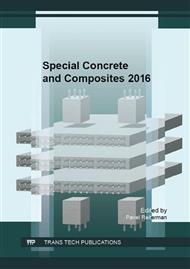[1]
V. Nežerka et al., Investigation of crushed brick-matrix interface in lime-based ancient mortar by microscopy and nanoindentation, Cement and Concrete Research 55 (2015) 122–128.
DOI: 10.1016/j.cemconcomp.2014.07.023
Google Scholar
[2]
V. Nežerka et al., Comprehensive study on mechanical properties of lime-based pastes with additions of metakaolin and brick dust, Cement and Concrete Research 64 (2014) 17–29.
DOI: 10.1016/j.cemconres.2014.06.006
Google Scholar
[3]
L. Evangelista, J. Brito, Mechanical behavior of concrete made with fine recycled concrete aggregates, Cement and Concrete Composites 29 (2007) 397–401.
DOI: 10.1016/j.cemconcomp.2006.12.004
Google Scholar
[4]
E.F. Ledesmaa et al., Properties of masonry mortars manufactured with fine recycled concrete aggregates, Construction and Building Materials 71 (2014) 289–298.
DOI: 10.1016/j.conbuildmat.2014.08.080
Google Scholar
[5]
M. Lidmila et al., Mechanical Properties of Recycled Binder/Micro-Filler Cement-Based Material, Advanced Materials Research 1054 (2014) 234–237.
DOI: 10.4028/www.scientific.net/amr.1054.234
Google Scholar
[6]
M. Lidmila et al., Utilization of Recycled Fine-ground Concrete from Railway Sleepers for Production of Cement-based Binder, Applied Mechanics and Materials 486 (2014), 323–326.
DOI: 10.4028/www.scientific.net/amm.486.323
Google Scholar
[7]
M. Lidmila et al., Utilization of Recycled Binder for Improvement of Subsoil under Railway Sleepers, Applied Mechanics and Materials 486 (2013) 323–326.
DOI: 10.4028/www.scientific.net/amm.486.323
Google Scholar
[8]
M. Lidmila et al., Composite Material Based on Cement and PVA: Evolution of Mechanical Properties During First 28 Days, Advanced Materials Research 1054 (2014) 215–220.
DOI: 10.4028/www.scientific.net/amr.1054.215
Google Scholar
[9]
J. Topič et al., Effect of PVA Modification on the Properties of Cement Based Composite, Acta Polytechnica 55 (1) (2015) 64–75.
Google Scholar
[10]
A. Podstawka et al. An Experimental investigation of the impact of fiber material on fracture energy of fibre reinforced concrete, Civil-Comp Proceedings 108 (2015).
Google Scholar
[11]
A. Kohoutková et al., Experimental verification of the behavior of protective steel liner of concrete containment, Key Engineering Materials 691 (2016) 3–13.
DOI: 10.4028/www.scientific.net/kem.691.3
Google Scholar
[12]
J. Fládr, A. Kohoutková, High performance concrete experimental structure, Advanced Materials Research 1000 (2014) 269–272.
DOI: 10.4028/www.scientific.net/amr.1000.269
Google Scholar
[13]
R. V. Silva et al., Properties and composition of recycled aggregates from construction and demolition waste suitable for concrete production. Construction and Building Materials 65 (2014), 201–217.
DOI: 10.1016/j.conbuildmat.2014.04.117
Google Scholar
[14]
D. Pedro et al., Influence of the use of recycled concrete aggregates from different sources on structural concrete. Construction and Building Materials 71 (2014), 141–151.
DOI: 10.1016/j.conbuildmat.2014.08.030
Google Scholar
[15]
F. Tomosawa et al., Towards completely recyclable concrete. Integrated design and environmental issues in concrete technology. E & FN Spon, London, 1996, p.263–272.
Google Scholar


